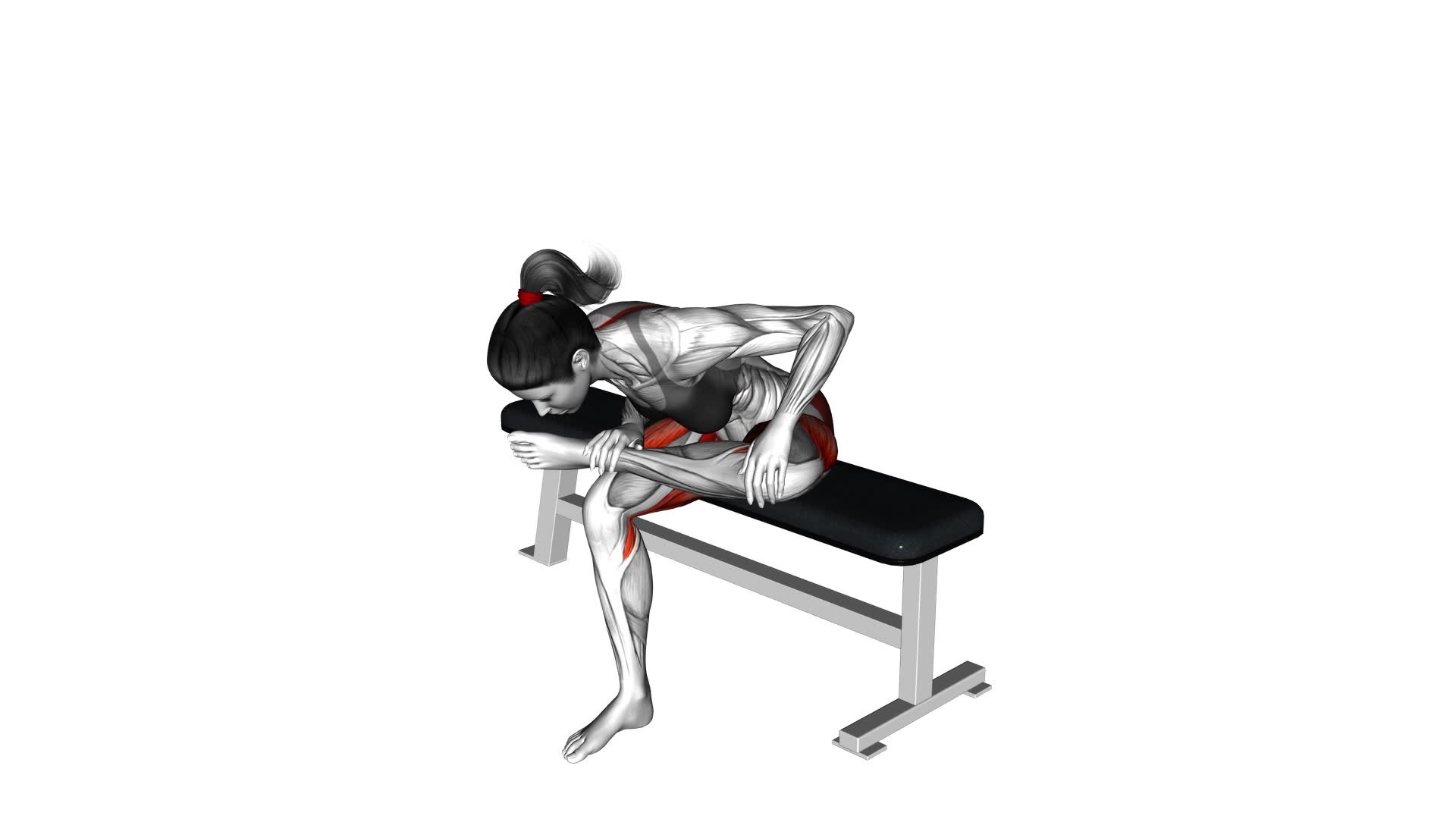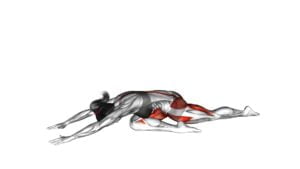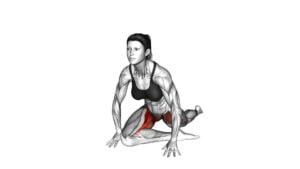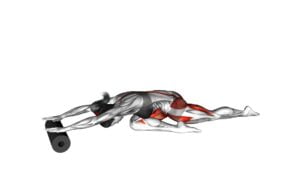Seated Pigeon Stretch (female) – Video Exercise Guide & Tips

Are you looking to improve your flexibility and strengthen your lower body? Look no further than the seated pigeon stretch!
Watch This Exercise Video
This video exercise guide and tips will help you properly perform this stretch to maximize its benefits. Whether you're a beginner or an experienced fitness enthusiast, we've got modifications and variations for all fitness levels.
Avoid common mistakes and get the most out of this stretch with our helpful tips.
Get ready to feel the burn and increase your flexibility with the seated pigeon stretch!
Key Takeaways
- Improved hip flexibility
- Increased range of motion
- Prevention of injuries
- Release of tension and tightness in the hip area
Benefits of the Seated Pigeon Stretch
You should regularly incorporate the seated pigeon stretch into your fitness routine to experience the numerous benefits it offers. One of the main benefits of this stretch is improved hip flexibility. By stretching the muscles in your hips, you can increase your range of motion and prevent injuries. This is especially important for athletes or individuals who engage in activities that require a lot of hip movement, such as running or dancing.
In addition to improving hip flexibility, the seated pigeon stretch also helps to release tension and tightness in the hip area. This can be particularly beneficial for those who spend long hours sitting or have sedentary lifestyles, as it helps to counteract the negative effects of prolonged sitting.
To deepen the stretch and further enhance its benefits, there are variations you can try. One option is to place a yoga block or folded blanket under the hip of the leg being stretched. This helps to elevate the hip and intensify the stretch. Another variation is to add a twist to the stretch by gently rotating your torso towards the side of the stretching leg. This not only stretches the hip, but also targets the muscles along your spine.
Incorporating the seated pigeon stretch into your fitness routine can have a positive impact on your overall hip flexibility and help alleviate tension in the hip area. Try different variations to deepen the stretch and maximize the benefits.
Proper Form and Alignment for the Seated Pigeon Stretch
To achieve proper form and alignment for the seated pigeon stretch, it's important to position your body correctly. Here are some key tips to help you maintain proper form and get the most out of this stretch:
- Sit on the floor with your legs extended in front of you. Bend your right knee and bring your right ankle to rest on top of your left thigh.
- Flex your left foot and ensure that your left knee is pointed directly forward.
- Keep your spine straight and engage your core to maintain a stable and balanced posture.
- Gently lean forward from your hips, maintaining a slight curve in your lower back. You should feel a stretch in your right outer hip and glute area.
By following these alignment cues, you'll optimize the benefits of stretching. The seated pigeon stretch helps to increase flexibility in the hips, release tension in the glutes, and improve overall hip mobility.
If you're a beginner or have tight hips, you can modify this stretch by placing a cushion or folded blanket under your right hip to elevate it slightly. This modification can help reduce strain on the knee and make the stretch more accessible. Remember to always listen to your body and adjust the stretch as needed.
Modifications and Variations for All Fitness Levels
To accommodate individuals of all fitness levels, modifications and variations can be incorporated into the seated pigeon stretch. These modifications and variations allow for customization based on personal needs, limitations, and injuries.
For beginners or those with limited flexibility, a modification of the seated pigeon stretch can be performed by sitting on a folded blanket or bolster to elevate the hips. This helps to alleviate pressure on the knees and hips, making the stretch more accessible. Additionally, using a strap or towel can assist in reaching the desired stretch by looping it around the foot and gently pulling towards the body.
For those looking to progress in their practice, variations of the seated pigeon stretch can be explored. One variation involves extending the opposite leg straight out in front, increasing the intensity of the stretch on the hip and glute muscles. Another variation is the reclined pigeon stretch, where the individual lies on their back, crossing one ankle over the opposite knee and gently pulling the legs towards the chest.
It is important to note that modifications should always be made to accommodate individual needs, injuries, and limitations. If you have any concerns or are unsure about which modifications to use, it's recommended to consult with a qualified fitness professional or healthcare provider.
Common Mistakes to Avoid During the Seated Pigeon Stretch
Avoid making the mistake of rushing through the seated pigeon stretch without proper alignment and engagement. To ensure you get the most out of this stretch and avoid potential injuries, here are some common mistakes to avoid:
- Lack of proper alignment: It's important to maintain proper alignment throughout the stretch. Avoid collapsing your chest and rounding your back. Instead, sit tall and lengthen your spine, keeping your shoulders relaxed and down.
- Neglecting engagement: Engaging the muscles in your core, glutes, and hips will help you deepen the stretch and protect your joints. Make sure to activate these muscles by gently pulling your belly button in towards your spine and squeezing your glutes.
- Overstretching: While it's important to feel a stretch, avoid pushing yourself too far. Overstretching can lead to strain or injury. Listen to your body and only go as far as feels comfortable for you.
- Holding your breath: Breathing is crucial during any stretch. Avoid holding your breath and instead focus on deep, controlled breaths. Inhale as you prepare for the stretch and exhale as you deepen into it.
Tips for Maximizing the Effectiveness of the Seated Pigeon Stretch
To maximize the effectiveness of the Seated Pigeon Stretch, it's important to focus on proper form techniques. Ensure that your back is straight, your hips are square, and you're feeling a gentle stretch in your glutes and hips.
Additionally, pay attention to the duration and frequency of the stretch. Aim for holding the stretch for 30 seconds to a minute, and repeat it 2-3 times on each side.
Proper Form Techniques
To maximize the effectiveness of the Seated Pigeon Stretch, focus on maintaining proper form throughout the exercise. Here are some tips to help you do it right:
- Avoid rounding your back: Keep your spine straight and elongated to prevent strain on your lower back.
- Engage your core: Activate your abdominal muscles to stabilize your body and deepen the stretch.
- Modify as needed: If you have tight hips or limited mobility, use props like blankets or blocks to support your knees and help you find a comfortable position.
- Add variations: Experiment with different arm positions, such as reaching overhead or placing your hands on your thighs, to target different areas of your hips and glutes.
By following these proper form techniques, you can ensure that you're getting the most out of your Seated Pigeon Stretch.
Now, let's move on to discussing the ideal duration and frequency for this exercise.
Duration and Frequency
Maximize the effectiveness of the Seated Pigeon Stretch by incorporating the recommended duration and frequency into your routine.
To achieve the best results, it's recommended to hold the stretch for 30 seconds to 2 minutes on each side. This duration allows enough time for the muscles to relax and lengthen.
As for frequency, aim to perform the Seated Pigeon Stretch at least 3 times a week. Consistency is key in improving flexibility and preventing muscle tightness.
However, it's important to listen to your body and not overdo it. If you feel any pain or discomfort, reduce the duration or frequency of the stretch.
Recommended Frequency and Duration for Performing the Seated Pigeon Stretch
You should aim to perform the seated pigeon stretch for a recommended frequency and duration to maximize its benefits. Here are some guidelines to help you incorporate this stretch into your routine effectively:
- Frequency: Ideally, you should aim to perform the seated pigeon stretch at least three times a week. This will give your muscles enough time to recover between sessions while still allowing for progress and flexibility improvement.
- Duration: Start by holding the seated pigeon stretch for 30 seconds on each side. As you become more comfortable with the stretch, gradually increase the duration to 60 seconds or longer. Remember to breathe deeply and relax into the stretch to enhance its effectiveness.
- Warm-up: Before performing the seated pigeon stretch, it's essential to warm up your body with a few minutes of light cardio exercises or dynamic stretches. This will help increase blood flow to your muscles and prepare them for stretching.
- Progression: As your flexibility improves, you can deepen the stretch by gently pressing your chest closer to your thighs or extending your upper body forward. However, always listen to your body and avoid pushing yourself too far to prevent injury.
Frequently Asked Questions
Can the Seated Pigeon Stretch Help With Knee Pain or Knee Injuries?
The seated pigeon stretch can be beneficial for knee pain and knee injuries. By stretching the hip muscles and increasing flexibility, it can help alleviate stress on the knee joint.
This stretch can also improve range of motion and promote better stability in the knee. Incorporating the seated pigeon stretch into your routine may provide relief and support for knee-related issues.
Remember to consult with a healthcare professional before starting any new exercise program, especially if you have a knee injury.
Is It Safe to Perform the Seated Pigeon Stretch if You Have Lower Back Issues?
If you have lower back issues, it's important to consider the safety of performing the seated pigeon stretch.
While the seated pigeon stretch can be beneficial for flexibility and hip mobility, it may not be suitable for everyone with lower back problems.
It's recommended to consult with a healthcare professional or a certified trainer to determine if modifications to the seated pigeon stretch or alternative stretches that target the lower back would be more appropriate for you.
Can the Seated Pigeon Stretch Improve Flexibility in the Hips and Groin?
Improving hip flexibility and increasing groin flexibility can be achieved through the seated pigeon stretch. By regularly performing this exercise, you can stretch and open up the muscles in your hips and groin area, enhancing your overall flexibility.
The seated pigeon stretch targets specific muscles, such as the glutes and hip rotators, helping to improve their range of motion. Incorporating this stretch into your routine can be beneficial for increasing flexibility in these areas.
Will the Seated Pigeon Stretch Help With Sciatica Pain?
The seated pigeon stretch can provide a range of benefits for your body.
It's known to help with sciatica pain by stretching the piriformis muscle, which can alleviate pressure on the sciatic nerve.
Additionally, this stretch can improve flexibility in the hips and groin, allowing for better range of motion.
There are also variations of the seated pigeon stretch that you can explore to target different areas and enhance the overall effectiveness of the exercise.
Can the Seated Pigeon Stretch Be Included in a Prenatal or Postnatal Exercise Routine?
Yes, the seated pigeon stretch can be included in both prenatal and postnatal exercise routines.
During pregnancy, it can be modified by using a cushion or bolster to support your belly and avoid putting pressure on your abdomen. This stretch helps to open up your hips, relieve tension, and improve flexibility.
After giving birth, it can aid in restoring pelvic and hip mobility, as well as relieving any lingering discomfort.
It's important to consult with your healthcare provider before starting any exercise routine during pregnancy or postpartum.
Conclusion
In conclusion, the seated pigeon stretch is a beneficial exercise for improving flexibility and relieving tension in the hips and lower back.
By maintaining proper form and alignment, individuals of all fitness levels can safely perform this stretch.
Avoiding common mistakes and following the recommended frequency and duration will maximize its effectiveness.
Incorporating the seated pigeon stretch into your fitness routine can help enhance overall flexibility and promote better posture.

Author
Years ago, the spark of my life’s passion ignited in my mind the moment I stepped into the local gym for the first time. The inaugural bead of perspiration, the initial endeavor, the very first surge of endorphins, and a sense of pride that washed over me post-workout marked the beginning of my deep-seated interest in strength sports, fitness, and sports nutrition. This very curiosity blossomed rapidly into a profound fascination, propelling me to earn a Master’s degree in Physical Education from the Academy of Physical Education in Krakow, followed by a Sports Manager diploma from the Jagiellonian University. My journey of growth led me to gain more specialized qualifications, such as being a certified personal trainer with a focus on sports dietetics, a lifeguard, and an instructor for wellness and corrective gymnastics. Theoretical knowledge paired seamlessly with practical experience, reinforcing my belief that the transformation of individuals under my guidance was also a reflection of my personal growth. This belief holds true even today. Each day, I strive to push the boundaries and explore new realms. These realms gently elevate me to greater heights. The unique combination of passion for my field and the continuous quest for growth fuels my drive to break new ground.







